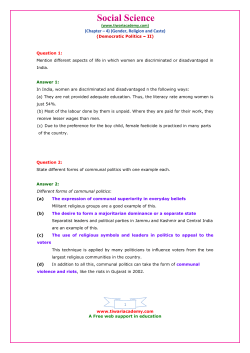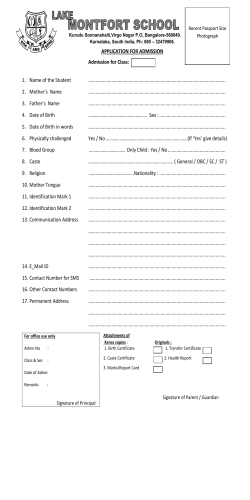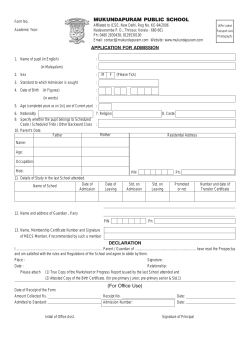
International Multidisciplinary Research Journal
ISSN No :2231-5063 Vol 4 Issue 10 April 2015 ORIGINAL ARTICLE International Multidisciplinary Research Journal Golden Research Thoughts Chief Editor Dr.Tukaram Narayan Shinde Associate Editor Dr.Rajani Dalvi Publisher Mrs.Laxmi Ashok Yakkaldevi Honorary Mr.Ashok Yakkaldevi Welcome to GRT RNI MAHMUL/2011/38595 ISSN No.2231-5063 Golden Research Thoughts Journal is a multidisciplinary research journal, published monthly in English, Hindi & Marathi Language. All research papers submitted to the journal will be double - blind peer reviewed referred by members of the editorial board.Readers will include investigator in universities, research institutes government and industry with research interest in the general subjects. International Advisory Board Flávio de São Pedro Filho Federal University of Rondonia, Brazil Mohammad Hailat Dept. of Mathematical Sciences, University of South Carolina Aiken Hasan Baktir English Language and Literature Department, Kayseri Kamani Perera Regional Center For Strategic Studies, Sri Lanka Abdullah Sabbagh Engineering Studies, Sydney Ghayoor Abbas Chotana Dept of Chemistry, Lahore University of Management Sciences[PK] Janaki Sinnasamy Librarian, University of Malaya Ecaterina Patrascu Spiru Haret University, Bucharest Romona Mihaila Spiru Haret University, Romania Loredana Bosca Spiru Haret University, Romania Delia Serbescu Spiru Haret University, Bucharest, Romania Fabricio Moraes de Almeida Federal University of Rondonia, Brazil Anurag Misra DBS College, Kanpur Anna Maria Constantinovici AL. I. Cuza University, Romania Ilie Pintea, Spiru Haret University, Romania Xiaohua Yang PhD, USA George - Calin SERITAN Faculty of Philosophy and Socio-Political Sciences Al. I. Cuza University, Iasi ......More Titus PopPhD, Partium Christian University, Oradea,Romania Editorial Board Iresh Swami Pratap Vyamktrao Naikwade ASP College Devrukh,Ratnagiri,MS India Ex - VC. Solapur University, Solapur R. R. Patil Head Geology Department Solapur University,Solapur Rama Bhosale Prin. and Jt. Director Higher Education, Panvel Salve R. N. Department of Sociology, Shivaji University,Kolhapur Govind P. Shinde Bharati Vidyapeeth School of Distance Education Center, Navi Mumbai Chakane Sanjay Dnyaneshwar Arts, Science & Commerce College, Indapur, Pune Awadhesh Kumar Shirotriya Secretary,Play India Play,Meerut(U.P.) N.S. Dhaygude Ex. Prin. Dayanand College, Solapur Narendra Kadu Jt. Director Higher Education, Pune K. M. Bhandarkar Praful Patel College of Education, Gondia Sonal Singh Vikram University, Ujjain Rajendra Shendge Director, B.C.U.D. Solapur University, Solapur R. R. Yalikar Director Managment Institute, Solapur Umesh Rajderkar Head Humanities & Social Science YCMOU,Nashik S. R. Pandya Head Education Dept. Mumbai University, Mumbai Alka Darshan Shrivastava G. P. Patankar S. D. M. Degree College, Honavar, Karnataka Shaskiya Snatkottar Mahavidyalaya, Dhar Maj. S. Bakhtiar Choudhary Director,Hyderabad AP India. Rahul Shriram Sudke Devi Ahilya Vishwavidyalaya, Indore S.Parvathi Devi Ph.D.-University of Allahabad S.KANNAN Annamalai University,TN Sonal Singh, Vikram University, Ujjain Satish Kumar Kalhotra Maulana Azad National Urdu University Address:-Ashok Yakkaldevi 258/34, Raviwar Peth, Solapur - 413 005 Maharashtra, India Cell : 9595 359 435, Ph No: 02172372010 Email: [email protected] Website: www.aygrt.isrj.org Golden Research Thoughts ISSN 2231-5063 Impact Factor : 3.4052(UIF) Volume-4 | Issue-10 | April-2015 Available online at www.aygrt.isrj.org HISTORICAL DEVELOPMENT OF UNTOUCHABILITY AND APPROACH OF THE CONSTITUTION TOWARDS IT Damodar M. Hake Assistant professor , Sinhgad Law College, Pune and Ph.D Scholar of SPPU, Pune . Short Profile Damodar M. Hake is working as an Assistant professor at Sinhgad Law College, Pune and Ph.D. Scholar of SPPU, Pune. He has completed B.S.L.LL.B., LL.M., Diploma(Law)., NET., Ph.D.(pursuing). He has teaching experience of 2 years. ABSTRACT: The origin of a very inhuman practice of “untouchability” is dated back to the Vedic period. It is widely acknowledged that traditional Indian society was based on Varna and Jati.The Hindu caste system is based on a social hierarchy which assigns untouchables to the lowest gladder of the society. Traditionally, the caste system was divided into four classes, or Varnas, i.e. the Brahmins, the Kshatriyas, the Vaishyas and the Shudras. Varna system provided in Vedas and Shastras are the basis of the inhuman practice of “untouchability” M.N. Srinivas writes, "In the Rigvedic hymn Purushasukta, the four Varna or order formed the limbs of primeval man (Purusha), who was victim in the divine sacrifice which produced the cosmos. The Brahmin emerged from his mouth, the Kshatriyas from his arms, the Vaishyas from his thighs and the Shudras from the feet". Last Varna from hierarchy of Varna system i.e. Shudras are today called Dalits or untouchables or the serfs and labourers. Peoples from other castes/classes, who considered themselves to be higher, believes that the Dalits are impure by birth and that their touch or sheer presence could be polluting hence, they are assumed to be untouchable. However, after independence the framers of the Indian Constitution adopted effective measures for abolition of untouchability by giving positive approach to this social problem. In this research paper researcher will conduct his research on Historical Development of inhuman practice of untouchability and the approach of the Constitutional makers for eradication of untouchability. KEYWORDS Untouchability, Vedas, Verna’s, Caste System, SC and ST etc. 1 HISTORICAL DEVELOPMENT OF UNTOUCHABILITY AND APPROACH OF THE CONSTITUTION TOWARDS IT “Untouchability is the notion of defilement; it is a case of permanent hereditary stain which nothing can cleanse.” Dr. Babasaheb B.R. Ambedkar INTRODUCTION:The first literary traces of the caste system were found in Rigveda and Pursasukta hymn. It is widely acknowledged that traditional Indian society was based on varna and jati. This system is very ancient in origin and through the passage of time it has undergone profound changes, but caste still a very powerful institution in our socio-economic, religious and political organization. The most disquietening and disturbing feature connected with the caste system has been the concept of untouchability. Untouchability is undoubtedly the most pernicious aspect of the caste system. In Shastric literature the Untouchables were known by various names like Chandala, Paulkasa, Shavpakas, asprshya etc. Apastamba Dharma Sutra says that after touching to Chandala, one should plunge into water on talking to him one should converse with a Brahmin, and on seeing him one should look at the luminaries of the sky such as the sun, the moon or the stars. Thus, we can presume and guess about the barbaric and inhuman practice of untouchability prevailed during ancient period. Constitutional framers have adopted various measures to overcome the problem of untouchability by prohibiting the practice of untouchability in any form and ensures that the justice to be done with the members of untouchable community. HISTORICAL DEVELOPMENT OF UNTOUCHABILITY:Untouchability is undoubtedly the most pernicious aspect of the caste system. The word "Caste" owes its origins to the Spanish word 'Casta' which means 'breed, race, strain or a complex of hereditary qualities.' The Portuguese applied this term to the classes of people in India, known by the name of 'jati.' The English word 'Caste' is an adjustment of the original term 'Casta. According to Henry Maine "Castes started as natural division of occupational classes and eventually upon receiving the religious sanction became solidified into the existing caste system. The caste system comes into being when it becomes an integral part of religious dogma which divides the people into superior and inferior groups with different responsibilities, functions and standards of living." Martindale and Monochest defined Caste as "an aggregate of persons whose share of obligations and privileges are fixed by birth, sanctioned and supported by religion and usage."According to Anderson and Parker "Caste is that extreme form of social class organization in which the position of individuals in the status hierarchy is determined by descent and birth." To understand the discrimination towards the Dalits of India, one must be knowledgeable of the caste system in India. A caste can be defined as a social class, made distinct from others by differences in rank, profession, or wealth. The caste system in India has been heavily influenced by the Hindu religion. In Hinduism, everyone is born into a caste (or jati) one cannot change his caste. Thus, it becomes clear from the Hindu ideology relating to caste or jati, that the birth of a person in particular community is sole deciding factor to ascertain the caste or jati of concern person. Scholars studying the history of India point out that the caste system might have evolved due to race. It is believed, that along with sacrificial religions, the Aryans might have integrated a caste system into the country, dominating the darker skinned natives (Majumder). Basically, there are four castes predominate in India. The Brahman, the priests and holy leaders, are the highest class, which is followed by the Kshatriya, the princes and warriors. The Vaishya are the farmers, merchants, and artisans of society, and the Shudra are servants 2 HISTORICAL DEVELOPMENT OF UNTOUCHABILITY AND APPROACH OF THE CONSTITUTION TOWARDS IT and workers. The lowest class is the Dalits, known as the untouchables. Nature of work being performed by person identifies their caste, status and position in the hierarchyof caste system prevailed society at that time. Those designated as untouchables, or Dalits, often concerned themselves with work that was considered “impure.” Work that involved killing, the disposal of waste, or the handling of corpses was reserved for this caste. Even today, we are living in so called modern India or free India of 21st century that Dalits are still seen as contaminated. Dalits cannot wear shoes in the presence of those in higher castes or they cannot celebrate their family functions as the members of higher castes can celebrate. Especially in UP, Bihar and MP Dalits cannot use horses or any luxurious amenity in marriages as far as rural area is concerned. Even to this day, untouchables are not allowed to enter in to the temples. Because the members of higher castes consider entry of Dalits in temple makes the temple impure. Good example is an incidence took place after an entry in temple by Mr. Jitan Ram Manzi, Ex. Chief Minister of the state of Bihar is evidence of the real fact that “untouchability” is still in existence after passing nearly about 68 years of the Independence. MEANING OF UNTOUCHABILITY:However, due to Constitutional prohibition and legal enforcement, gravity and nature of the social problem of untouchability is mitigated up to large extent. The Constitution India provides various safeguards for the untouchables. Most important provision from the Constitution i.e. Abolition Indian Constitution have adopted affirmative action to deal with the disadvantaged group of peoples known as SC and ST. Constitutional framers were enough aware about the nature and the gravity of the evil practice of Untouchability. Therefore they provided various Articles in the Constitution which enables the Government to frame and adopt various types of policies and welfare schemes for upliftment of untouchables by way of protective discrimination in their favour. Thus Government has passed various Acts for giving effect to the mandates laid down in the Constitution and also appointed Commission for studying grass root problems of disadvantaged community in India. Protective discrimination includes reservation in educational field, Public Employment, Parliamentary elections, State legislatures, Local Governments etc. which helps to the members of untouchable community to mingle with non- untouchable persons resulting slowly but steadily change in social status and position of untouchables. CONCLUSION:Ancient history had witnessed the barbaric practice of Untouchability. However, modern reformations, such as civil rights, have helped to improve and raise awareness of the conditions of the lowest castes. The Constitution of India a fundamental law of land contains various provisions for eradication of Untouchability. Preamble, Part-III, Part- IV etc. plays vital role in abolition of Untouchability form Indian social structure. Due to effective legislative framework instances of Untouchability lessened up to the large extent. Along with domestic measures, effective policy adopted by UNO at International level is very useful in curbing the problem of Untouchability. Today, due to civilization and urbanization the caste system is not rigidly adhered as it was adhered during Ancient time. Indian government has created a number of legal provisions giving untouchables greater rights. Article 17 of the Indian Constitution officially abolished the concept of Untouchability. Discrimination 3 HISTORICAL DEVELOPMENT OF UNTOUCHABILITY AND APPROACH OF THE CONSTITUTION TOWARDS IT against the Dalits is less apparent in sub-urban areas of India, where the population is more dense, and people from many different castes mingle together. In rural areas, however, extremely harsh conditions may arise for members of the Dalit. For the purpose introducing desired change, as expected by framers of Indian Constitution as far as abolition of Untouchability is concerned, awareness among the members of untouchable community about the rights should be created. At the same time effective measures should be applied for introducing changes in the psychology of non-untouchable members of society. REFERENCES:i)Michel S.M., Dalitas in Modern India : Vision and Values, (2nd ed.,2011) SAGE Publications ii)Ketkar, S.V., The History of Castes in India, (1990) , Low Price Publications, Delhi iii)Anderson and Parker, Society, in An Introduction to Sociology,( Vidya Bhushan and Sachdeva, D.R, 1999), Allahabad. iv)A History of the Untouchables: The Buraku and the Dalit, http://www.agorajournal.org/2006/History%20of%20Untouchables.pdf v)Dr. Vijaykumar H. Salimani, “Eradication of Untouchability”(A Case Study of Post Independent Karnataka) ,(1st ed., 2013), Laxmi Book Publication, Solapur. vi)Understanding Untouchability http://www.quantoid.net/papers/Untouchability.pdf __________________________________________________________________________ 1.Michel S.M., Dalitas in Modern India: Vision and Values, p.46, (2nd ed., 2011) SAGE Publications. 2.Ketkar, S.V., The History of Castes in India, p.12, (1990) , Low Price Publications, Delhi 3.Anderson and Parker, Society, p.370 in An Introduction to Sociology,( Vidya Bhushan and Sachdeva, D.R, 1999), Allahabad. 4.A History of the Untouchables: The Buraku and the Dalit, available at http://www.agorajournal.org/2006/History%20of%20Untouchables.pdf, last seen on 15/04/1511:16am 5. Ibid 6.Ibid 7.Dr. Vijaykumar H. Salimani, “Eradication of Untouchability”(A Case Study of Post Independent Karnataka) ,p. 5 (1st ed.,2013), Laxmi Book Publication, Solapur. 8. Ibid 9.Ibid at 6. 10.Understanding Untouchability, available at http://www.quantoid.net/papers/Untouchability.pdf , last seen on 08/04/15-12:32pm. 11.Art. 17, the Constitution of India, Abolition of Untouchability 4 Publish Research Article International Level Multidisciplinary Research Journal ForORIGINAL All Subjects ARTICLE Dear Sir/Mam, We invite unpublished Research Paper,Summary of Research Project,Theses,Books and Book Review for publication,you will be pleased to know that our journals are Associated and Indexed,India ? International Scientific Journal Consortium ? OPEN J-GATE Associated and Indexed,USA EBSCO ? ? Index Copernicus ? Publication Index ? Academic Journal Database ? Contemporary Research Index ? Academic Paper Databse ? Digital Journals Database ? Current Index to Scholarly Journals ? Elite Scientific Journal Archive ? Directory Of Academic Resources ? Scholar Journal Index ? Recent Science Index ? Scientific Resources Database ? Directory Of Research Journal Indexing Golden Research Thoughts 258/34 Raviwar Peth Solapur-413005,Maharashtra Contact-9595359435 [email protected]/[email protected] Website : www.aygrt.isrj.org
© Copyright 2025









